China Automotive Multimodal Interaction Development Research Report, 2022
Multimodal interaction research: more hardware entered the interaction, immersive cockpit experience is continuously enhanced
ResearchInChina's “China Automotive Multimodal Interaction Development Research Report, 2022” conducts analysis and research from three aspects: the installation status of mainstream interaction modes, the application of mainstream vehicle models’ interaction modes, and cockpit interaction solutions of suppliers.
1. Guided by the "third space" concept, multimodal interaction is being deeply applied to intelligent cockpit with five main features.
(1) With the trend of large screen, multi-screen and smart surface materials, touch interaction has gradually expanded its application range
The large screen of center console makes touch control the mainstream interaction mode. For example, Mercedes-Benz EQS and XPeng P7 have almost no physical buttons on the center console, but all done by touch.
Multi-screen cockpits make touch range from the front to the rear, from the center console / co-pilot infotainment extended to the doors, windows, seats and other components. For example, Li Auto L9 eliminates the traditional instrument panel and replaces it with a small TouchBar above the steering wheel; in addition, it also carries a co-pilot screen and rear audio/video screen to achieve five-screen interaction.
(2) Voice interaction evolves from passive to active, personalized and emotional demands will be met
See-and-speak, continuous dialogue, voice source location, wake-up free and other voice technology has been widely equipped in the new cars launched in 2022, the voice interaction mode tends to be more natural.
Personalized experience is currently the focus of the voice function, and intelligent EV brands such as NIO/XPeng/Li Auto are mainly optimized in voice customization, image customization, skill customization, etc.
In the future, the concept of emotional companionship and electronic pets is expected to be realized with the help of voice function.
(3) Face recognition algorithm promotes DMS, OMS and IMS scale installation
Face recognition-based ID login and user habit presets have been implemented in NIO ET7/ET5, XPeng P7/G9, AITO M5/M7, Neta S, and Voyah Dreamer. Among them, AITO can automatically login to Huawei account through face recognition, linking schedule, navigation information, call records, music and video membership rights, third-party application data, and automatic switching of driving information to achieve information flowing.
Face payment function application is still relatively small, which has been installed on Toyota Harrier Premium Edition, and XPeng P7 will be achieved it through OTA upgrade.
Face recognition-based DMS, OMS, and IMS are being installed on a large scale and will promote in-cockpit camera equipment.
(4) Gesture recognition function is single, installed as a complementary interaction mode
Currently, gesture recognition mainly applied to multimedia switching, volume control, phone answering, lighting control, etc., mainly installed as a supplementary interaction mode.
In the future, gesture recognition is expected to be combined with ADAS functions to achieve vehicle summoning, starting and parking based on exterior visual perception.
(5) Fingerprint, iris, vein, heart rate and other biometric applications in the car are still in the exploration stage
Fingerprint is expected to be applied in user ID recording and in-vehicle payment scenarios.
Iris/eye tracking will enhance the accuracy of in-cockpit monitoring such as DMS, and have imagination space in the future in intention prediction and active recommendation.
Vein/heart rate, etc., will be applied under the concept of in-vehicle health.
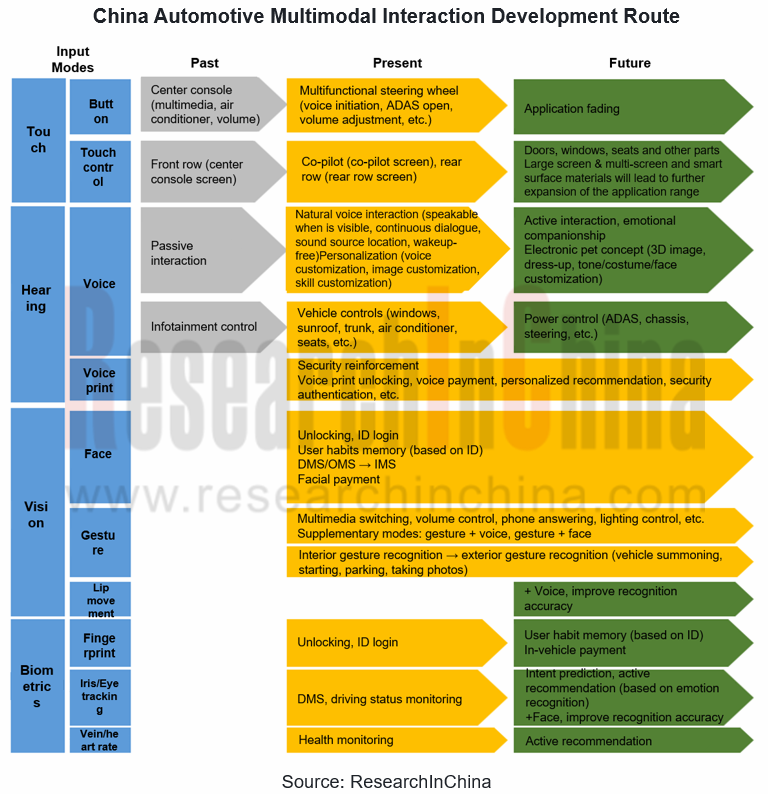
2. Multimodal recognition and large & multi-screen, AR-HUD, AR/VR, ambient light, high-quality audio and other hardware interaction to be enhanced, immersive cockpit experience continues to grow
(1) Li Auto L9, creating a multimodal interaction experience through five-screen, voice and gestures
Features of Li Auto L9 interaction:
Replaces the traditional instrument screen with HUD + safe driving interaction screen.
Enhances the audiovisual experience through 15.7-inch center console screen + 15.7-inch co-pilot screen + HUD + safe driving interaction screen + 15.7-inch rear entertainment screen with 3K HD resolution and high color reproduction on the automotive screen.
6-voice-zone recognition interaction (AISpeech ) + self-developed speech engine (in cooperation with Microsoft) + 3D ToF sensor (gesture interaction, cockpit monitoring), to achieve multimodal interaction.
Voice + gesture integration, such as point at the sunshade and say "open this", that is, open the sunshade.
Connect to Nintendo Switch via Type-C and rear entertainment screen to create cockpit gaming scenarios.
Two Qualcomm Snapdragon 8155 chips, 24GB RAM + 256G high-speed storage, and dual-5G operator switching to provide computing power and network support.
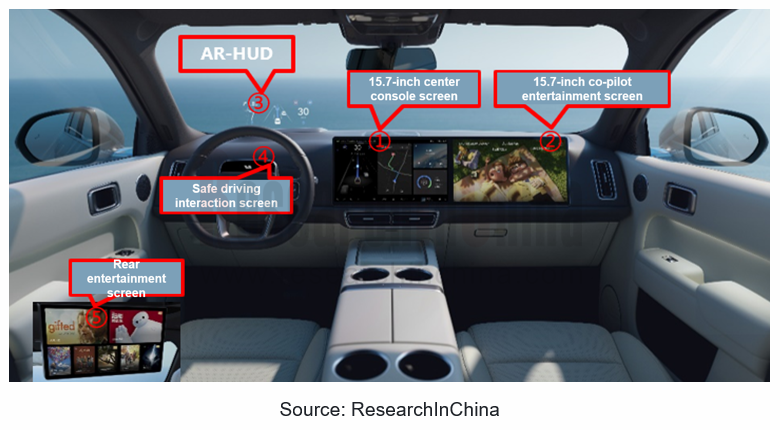
(2) NIO, Li Auto, Audi and others take the lead in AR/VR glasses installation for an immersive cockpit experience
Jointly developed with NREAL, the NIO AR glasses can project a 6m viewing distance and 201-inch-equivalent screen (optional price RMB 2,299). VR glasses are jointly developed with NOLO, and equipped with ultra-thin Pancake optical lenses for binocular 4K display.

Li Auto AR glasses are provided by Leiniao Technology, a subsidiary of TCL, and the product was available on Li Auto Store from August 2022. Leiniao Air adopts the polarization Birdbath + MicroOLED technology solution and is directly connected to the rear audio and video system of Li Auto L9. Plugging the cable at the legs of the glasses into Li Auto's rear-row DP jack provides users with a 140-inch giant screen (4m distance) viewing experience.
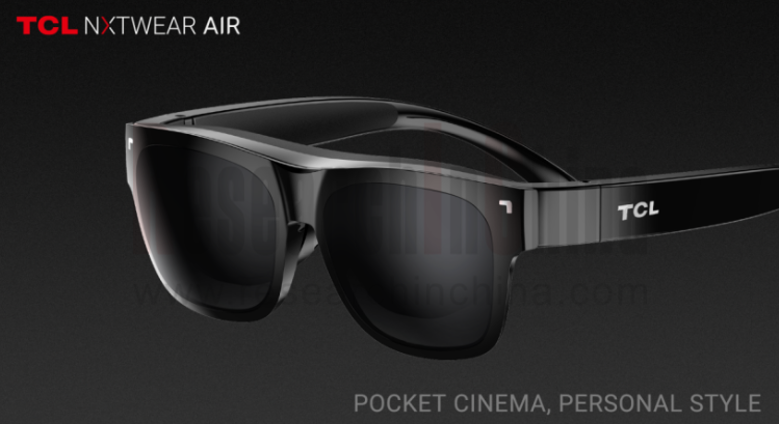
Audi VR glasses will be first launched in USA in 2023. The hardware is supported by HTC and integrated into Holoride Pioneers' Pack in-vehicle entertainment system for games and video scenarios.
3. Chip, algorithm and system integrator work together to create active cockpit interaction based on multimodal interaction
(1) Chip companies, represented by Horizon, integrate multimodal interaction into intelligent driving solution
Horizon Halo, a cockpit solution built by Horizon based on Journey 2 and Journey 3, can integrate vision, voice and other sensor data to achieve active interaction. Among them, Halo 3.0 can provide a complete set of AI solutions including DMS, face detection, behavior detection, gesture recognition, child behavior detection, multimodal voice interaction and other functions for front and rear row users.
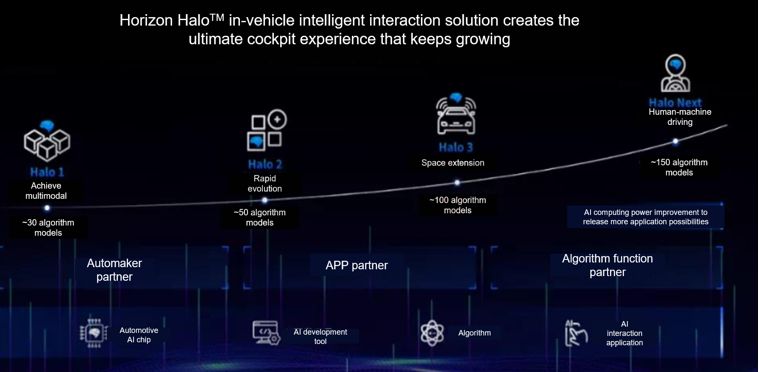
(2) iFLYTEK, Cerence, etc. entered with voice, and SenseTime, ArcSoft, etc. entered with vision to achieve the integration of superior modes with other modes to create an overall cockpit solution
iFLYTEK builds a multimodal system based on "listening, speaking, seeing and displaying" all-link technology, realizing that the vehicle can process the fusion of voice, image, live body and other information throughout the car-using cycle of getting on - driving - getting off, so as to understand passengers' information more actively and deeply, and thus actively care for them, push relevant contents/services, and change vehicle settings to explore disruptive interaction experience.
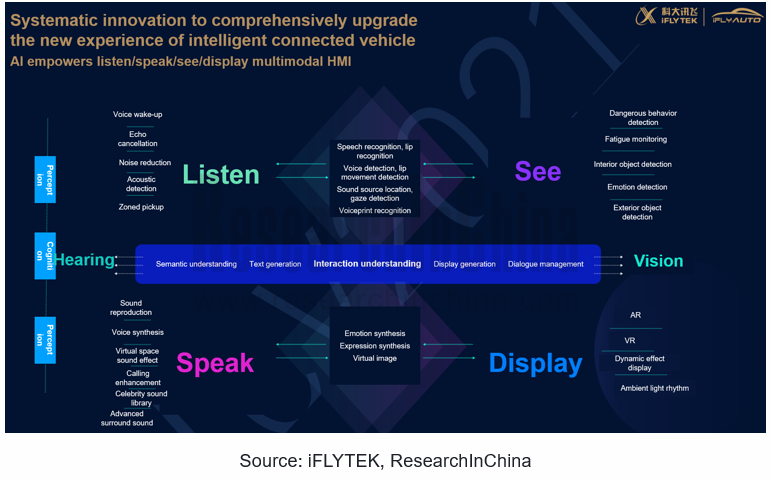
Based on its strengths in voice, Cerence will integrate vehicle data (fatigue monitoring, mobile phone interconnection, entertainment system, air conditioner, fuel, charging, seat, GPS, air quality) with in-vehicle multimodal interaction (voice, speech synthesis, text input, eye tracking, gesture recognition, emotion recognition, biometrics) to create immersive cockpit interaction in the future.
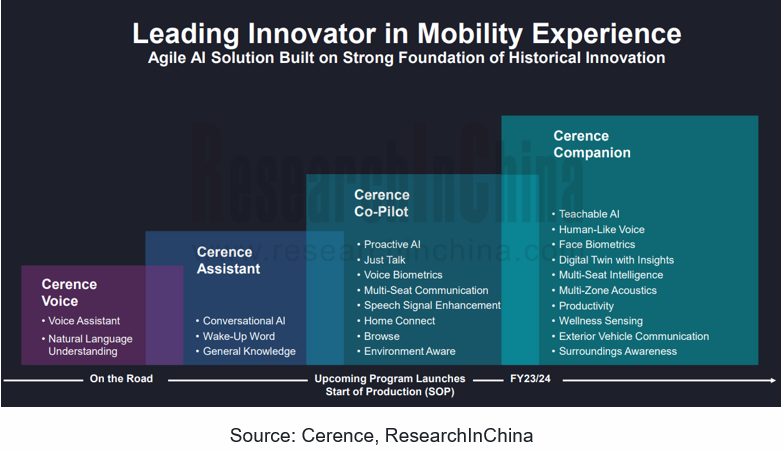
(3) ADAYO, Desay SV and other Tier1, combining multimodal interaction with scenarios to create a personalized cockpit experience
Based on high computing power AI chip, through visual, auditory, touch, multimodal front-fusion, multimodal rear-fusion and other recognition technologies, ADAYO multimodal interaction system can realize 4 major categories and 70+ human-machine interaction scenarios, including voice + gesture to open the window or air conditioner, see-and-speak, greeting when getting into the car, soothing children crying, voice control, face start engine, eye control to light up screen, driver behavior monitoring and dangerous behavior reminder, etc., providing users with active emotional multimodal interaction scenario experience and meeting the personalized needs of thousands of users.
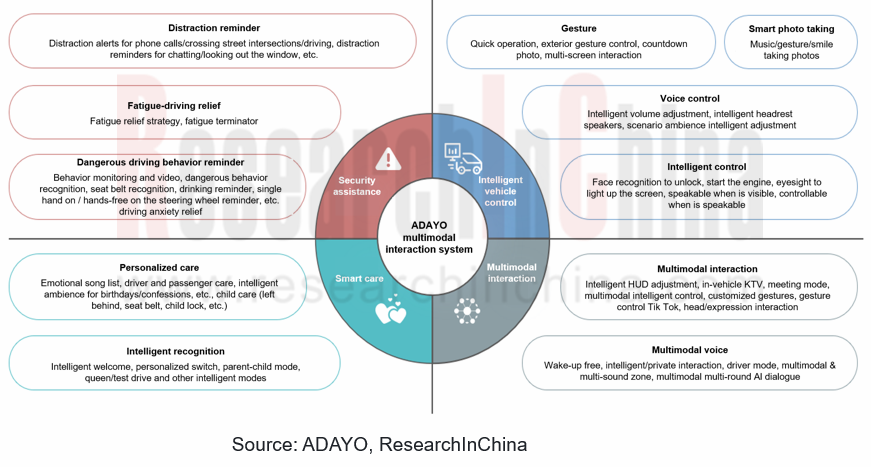
New Energy Vehicle Cross-Domain (Electric Drive System and Powertrain Domain) Integration Trend Report 2025-2026
Electric Drive and Powertrain Domain Research: New technologies such as three-motor four-wheel drive, drive-brake integration, and corner modules are being rapidly installed in vehicles.
Electric dri...
Analysis on Desay SV and Joyson Electronic's Electrification, Connectivity, Intelligence and Sharing, 2025
Research on Desay SV and Joyson Electronic: Who is the No.1 Intelligent Supplier?
Both Desay SV and Joyson Electronic are leading domestic suppliers in automotive intelligence. "Analysis on Desay SV ...
OEMs and Tier 1 Suppliers' Cost Reduction and Efficiency Enhancement Strategy Analysis Report, 2025
ResearchInChina released the "OEMs and Tier 1 Suppliers' Cost Reduction and Efficiency Enhancement Strategy Analysis Report, 2025", summarizing hundreds of cost reduction strategies to provide referen...
Automotive Fixed Panoramic Sunroof and Smart Roof Research Report, 2025
With the intelligent application of car roofs as the core, this report systematically sorts out a series of new products such as fixed panoramic sunroof/openable sunroof, ceiling screen, roof ambient ...
Automotive-Grade Power Semiconductor and Module (SiC, GaN) Industry Research Report, 2025
SiC/GaN Research: Sales volume of 800V+ architecture-based vehicles will increase more than 10 times, and hybrid carbon (SiC+IGBT) power modules are rapidly being deployed in vehicles.
Sales volume o...
Cockpit Agent Engineering Research Report, 2025
Cockpit Agent Engineering Research: Breakthrough from Digital AI to Physical AI
Cockpit Agent Engineering Research Report, 2025 starts with the status quo of cockpit agents, summarizes the technical ...
Prospective Study on L3 Intelligent Driving Technology of OEMs and Tier 1 Suppliers, 2025
L3 Research: The Window of Opportunity Has Arrived - Eight Trends in L3 Layout of OEMs and Tier 1 Suppliers
Through in-depth research on 15 OEMs (including 8 Chinese and 7 foreign OEMs) and 9 Tier 1 ...
China Commercial Vehicle IoV and Intelligent Cockpit Industry Research Report 2025
Commercial Vehicle IoV and Cockpit Research: The Third Wave of Passenger Car/Commercial Vehicle Technology Integration Arrives, and T-Box Integrates e-Call and 15.6-inch for Vehicles
I. The third wav...
Intelligent Vehicle Electronic and Electrical Architecture (EEA) and Technology Supply Chain Construction Strategy Research Report, 2025
E/E Architecture Research: 24 OEMs Deploy Innovative Products from Platform Architectures to Technical Selling Points
According to statistics from ResearchInChina, 802,000 passenger cars with domain...
Research Report on Intelligent Vehicle Cross-Domain Integration Strategies and Innovative Function Scenarios, 2025
Cross-Domain Integration Strategy Research: Automakers' Competition Extends to Cross-Domain Innovative Function Scenarios such as Cockpit-Driving, Powertrain, and Chassis
Cross-domain integration of ...
China Autonomous Driving Data Closed Loop Research Report, 2025
Data Closed-Loop Research: Synthetic Data Accounts for Over 50%, Full-process Automated Toolchain Gradually Implemented
Key Points:From 2023 to 2025, the proportion of synthetic data increased from 2...
Automotive Glass and Smart Glass Research Report, 2025
Automotive Glass Report: Dimmable Glass Offers Active Mode, Penetration Rate Expected to Reach 10% by 2030
ResearchInChina releases the Automotive Glass and Smart Glass Research Report, 2025. This r...
Passenger Car Brake-by-Wire (BBW) Research Report, 2025
Brake-by-Wire: EHB to Be Installed in 12 Million Vehicles in 2025
1. EHB Have Been Installed in over 10 Million Vehicles, A Figure to Hit 12 Million in 2025.
In 2024, the brake-by-wire, Electro-Hydr...
Autonomous Driving Domain Controller and Central Computing Unit (CCU) Industry Report, 2025
Research on Autonomous Driving Domain Controllers: Monthly Penetration Rate Exceeded 30% for the First Time, and 700T+ Ultrahigh-compute Domain Controller Products Are Rapidly Installed in Vehicles
L...
China Automotive Lighting and Ambient Lighting System Research Report, 2025
Automotive Lighting System Research: In 2025H1, Autonomous Driving System (ADS) Marker Lamps Saw an 11-Fold Year-on-Year Growth and the Installation Rate of Automotive LED Lighting Approached 90...
Ecological Domain and Automotive Hardware Expansion Research Report, 2025
ResearchInChina has released the Ecological Domain and Automotive Hardware Expansion Research Report, 2025, which delves into the application of various automotive extended hardware, supplier ecologic...
Automotive Seating Innovation Technology Trend Research Report, 2025
Automotive Seating Research: With Popularization of Comfort Functions, How to Properly "Stack Functions" for Seating?
This report studies the status quo of seating technologies and functions in aspe...
Research Report on Chinese Suppliers’ Overseas Layout of Intelligent Driving, 2025
Research on Overseas Layout of Intelligent Driving: There Are Multiple Challenges in Overseas Layout, and Light-Asset Cooperation with Foreign Suppliers Emerges as the Optimal Solution at Present
20...